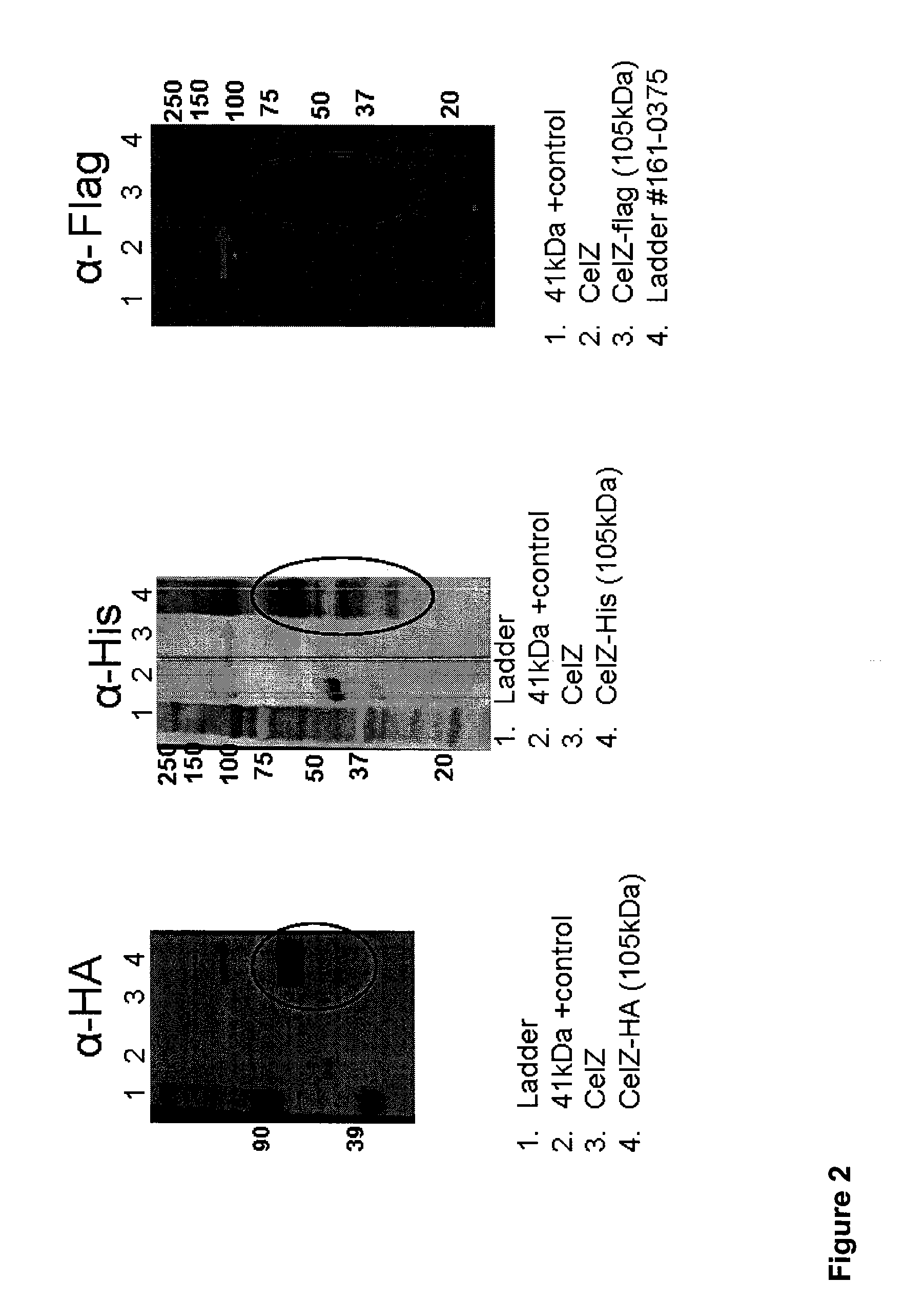Heterologous Biomass Degrading Enzyme Expression in Thermoanaerobacterium Saccharolyticum
a technology of biomass degrading enzyme and thermoanaerobic bacteria, which is applied in the field of molecular biology, can solve the problems of inability to achieve sufficient levels of secreted enzymes to be industrially useful, inability to efficiently hydrolyze cellulose, and inability to gram positive thermoanaerobic bacteria to achieve sufficient levels of secreted enzymes, etc., to achieve the effect of reducing protease activity and increasing chaperone activity
- Summary
- Abstract
- Description
- Claims
- Application Information
AI Technical Summary
Benefits of technology
Problems solved by technology
Method used
Image
Examples
example 1
Creation of M0355 Strain
[0216]A strain of T. sacch that was engineered to remove genes necessary for acetate and lactate production has previously been described. Shaw A J et al. Proc Natl Acad Sci. 105: 13769-74 (2008). However, selection for plasmids based on kanamycin resistance cannot be performed using this strain because the kanamycin resistance gene is already present in it. Thus, the strain M0355 was engineered to remove genes necessary for acetate and lactate production, but does not contain any antibiotic resistance genes. Strain M0355 was made using the widely-implemented strategy of counterselection to remove unwanted DNA sequences from the bacterial genome of a Thermoanaerobacterium saccharolyticum strain. (See Reyrat et al. Infection and Immunity 66:4011-4017 (1998)).
[0217]The following DNA sequence was removed from the thermophilic anaerobic bacterium Thermoanaerobacterium saccharolyticum JW / SL-YS485 (DSM #8691). This is a non-hazardous, non-pathogenic bacterium that ...
example 2
Expression of CelZ in T. sacch
[0222]The gene CelZ was PCR-amplified from genomic DNA from C. stercorarium and then cloned into a plasmid vector as shown in FIG. 1. After verification of plasmid construction, the plasmid DNA was transformed into T. sacch strain M0355 and selected by plating on agar plates containing kanamycin. T. sacch M0355 strains expressing CelZ (native C. stercorarium sequence) alone or CelZ fused to C-terminal tags 6×His (HHHHHH) (SEQ ID NO:160), Flag (DYKDDDDK) (SEQ ID NO:161), or Hemagglutinin (HA) (YPYDVPDYA) (SEQ ID NO:162) were grown overnight to an OD600>2.0 in M122 media, pH 6.1 supplemented with 5 g / L cellobiose. Cells were separated from supernatants by centrifugation, and supernatant proteins were precipitated using a DOC / TCA method. Proteins were separated by SDS-PAGE gel electrophoresis on Novex® 4-20% Tris-Glycine Gels and transferred to polyvinylidene fluoride (PVDF) membranes. Proteins were detected using either anti-6×His (Qiagen 34660), anti-Fl...
example 3
Expression of E5 and CBH1 in T. sacch
[0223]Vectors encoding T. fusca E5, Talaromyces emersonii CBH1, Cellulomonas fimi cex and Nasutitermes takasagoensiswere NtEG were also transformed in the M0355 strain. In these experiments, the transformed cells were grown in M122C, pH 6.1 with 5 ug / mL thiamphenicol at 47° C. Overnight cultures and cultures in stationary phase (OD600=1.9-2.1) for 2 hours were assayed for protein expression. Cells were separated from supernatant by centrifugation, and 5 mL culture supernatant was precipitated overnight using DOC / TCA. Protein pellets were resuspended in SDS-PAGE gel loading buffer and analyzed by gel electrophoresis prior to Western blotting with anti His antibodies. Both E5 and CBH1 were detected from culture supernatants from both overnight and stationary cultures as shown in FIG. 3.
PUM
| Property | Measurement | Unit |
|---|---|---|
| nucleic acid | aaaaa | aaaaa |
| lactic acid | aaaaa | aaaaa |
Abstract
Description
Claims
Application Information
 Login to View More
Login to View More - R&D
- Intellectual Property
- Life Sciences
- Materials
- Tech Scout
- Unparalleled Data Quality
- Higher Quality Content
- 60% Fewer Hallucinations
Browse by: Latest US Patents, China's latest patents, Technical Efficacy Thesaurus, Application Domain, Technology Topic, Popular Technical Reports.
© 2025 PatSnap. All rights reserved.Legal|Privacy policy|Modern Slavery Act Transparency Statement|Sitemap|About US| Contact US: help@patsnap.com



